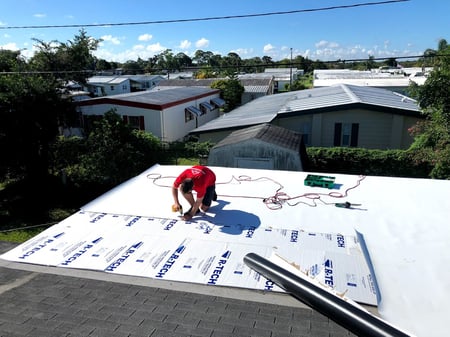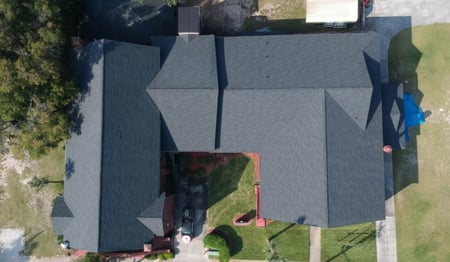Roof Replacements With Pets: What You Need to Know
November , 2024 | 6 min. read

When it’s time to replace your roof, there’s no shortage of things to plan. You’ve got the materials to choose, contractors to coordinate, and maybe even a nosy neighbor or two keeping tabs on your progress. But if you’re a pet owner, there’s one more important question to answer: What about my pets?
At RoofCrafters, we hear this question quite frequently! Do you need to relocate them while the roofers are hard at work? Or can they stay home and supervise (preferably from their favorite napping spot)?
If you've ever had to ask yourself these things or have even put off a roofing project out of pet fear, you're in the right place. Let’s dive into how to navigate a roof replacement while keeping your furry, feathery, or scaly friends safe and stress-free.
The Noise Factor

If you’ve ever been near a roof replacement project, you know it’s not exactly a quiet affair. There’s hammering, banging, and the occasional whir of power tools, which are all sounds that could send your dog under the bed or leave your cat plotting revenge.
Pets with sensitive hearing, like dogs, cats, and even rabbits, can be particularly affected by the commotion. Prolonged exposure to loud noises may cause stress, anxiety, or even physical discomfort for animals with acute hearing abilities. Signs of stress can range from hiding and trembling to refusing food or showing uncharacteristic aggression.
Solution: If your pet is particularly noise-sensitive, it might be worth arranging a temporary relocation, whether that’s to a friend’s house, a pet boarding facility, or even a quiet room on the far side of your home. For pets that are less phased by noise, a white noise machine or calming pet music (yes, it’s a thing!) might help drown out the racket.
Safety First
Roof replacements involve a lot of materials coming and going. Nails, shingles, and other debris are bound to fall during the process. For pets that like to roam outdoors, this can be a recipe for trouble. Curious dogs and outdoor cats might explore the yard and find themselves in harm’s way.
Solution: For outdoor-loving pets, it’s best to keep them inside while the work is happening. If they’re the type who gets stir-crazy indoors, designate a safe area in the yard far from the roofing activity.
A sturdy fence or portable pet enclosure can work wonders here. And for the truly adventurous pets, double-check windows and doors to ensure they don’t make a break for it.
Stranger Danger

Let’s face it: pets aren’t always thrilled about strangers invading their territory, even if those strangers are there to give your home a much-needed upgrade. Roofers climbing ladders and walking around in safety gear might make your pets feel uneasy. This is especially true for territorial dogs or cats who prefer their human’s lap to any new visitor.
Solution: Create a pet-safe zone in your home - a quiet, enclosed space away from the action. This could be a bedroom, laundry room, or even a bathroom, complete with cozy bedding, food, water, and a favorite toy. For pets prone to anxiety, consider using calming sprays or pheromone diffusers to create a more soothing environment.
What About Birds, Fish, and Exotic Pets?
While dogs and cats are the most common household pets, let’s not forget about our avian, aquatic, and reptilian friends. Birds, for example, are highly sensitive to noise and air quality. Dust and debris from roof work can pose serious health risks to birds if inhaled.
Fish tanks are another consideration. The vibrations from heavy machinery can disturb aquatic pets, potentially leading to stress or shock. Reptiles and small mammals like guinea pigs might also feel vibrations and noise more acutely than larger animals.
Solution: For birds, fish, and exotic pets, relocation is often the safest option. If moving their habitat isn’t feasible, place them in the farthest room from the roofing work and ensure proper ventilation. Cover fish tanks with a towel to block out noise and dust while keeping the water’s temperature stable.
Keeping Routine: The Key to a Happy Pet

Pets thrive on routine. Disruptions like construction work can throw them off their game, whether it’s missing their usual afternoon sunbathing spot or not getting their regular walk because the yard is off-limits.
Solution: Stick to your pet’s schedule as much as possible. If they’re used to a morning walk, take them out before the roofers arrive. Keep mealtime consistent, and don’t forget those belly rubs or head scratches, they might need a little extra TLC to feel secure.
What If Relocation Isn’t an Option?
Sometimes, relocating your pets isn’t practical. Maybe you have a cat who treats car rides like a personal vendetta, or perhaps your dog has separation anxiety that makes boarding facilities a no-go. If staying put is the only option, here’s how to make it work:
• Communication is key: Let your roofing contractor know you have pets. Most professionals will take extra care to minimize noise and debris around your home.
• Create a safe space: Block off a quiet room with all your pet’s essentials and consider adding some calming elements like pet pheromones or aromatherapy.
• Monitor closely: Keep a close eye on your pets’ behavior throughout the process. If they seem particularly stressed, consult your veterinarian for advice.
When the Work Is Done: Post-Roof Replacement Tips

Once the roofers pack up and leave, your job isn’t quite done, at least not where your pets are concerned. Check the yard for stray nails, sharp debris, or leftover materials that could pose a hazard. Walk your dog on a leash initially to ensure the area is safe before letting them roam freely. For cats, give the outdoors a once-over before letting them resume their prowling adventures.
It’s also a good idea to vacuum and dust the interior of your home to remove any stray particles that might have drifted inside during the work. This is especially important for pets with respiratory sensitivities.
Roof Replacement With Pets: A Balancing Act
All in all, balancing a roof replacement with pet care can feel like a juggling act, but with a bit of preparation, it’s entirely manageable. Whether you relocate your pets temporarily or create a safe haven for them at home, the key is to prioritize their safety and comfort.
And let’s be honest, once the new roof is installed and your home is looking sharp, your pets will probably forget the whole ordeal ever happened. Except for the cats, they’ll hold a grudge.
In the end, your pets will thank you (probably with extra snuggles) for keeping their well-being in mind during what’s sure to be a noisy, busy time. So, please take a deep breath, grab your favorite treat, and get ready to tackle that roof replacement like the responsible pet parent you are. If you're ready to take the leap, be sure to hit that "Schedule an Inspection" button below!
My name is Cassie, and I’m the Content Manager here at RoofCrafters. I was born and raised in Chicago, Illinois, and made my way out to Florida post-college graduation. I’m incredibly passionate about writing and creating valuable content that helps others with the collaboration of my marketing team. When I’m not working, I enjoy shopping (a little too much), spending time at the beach, and reading!



